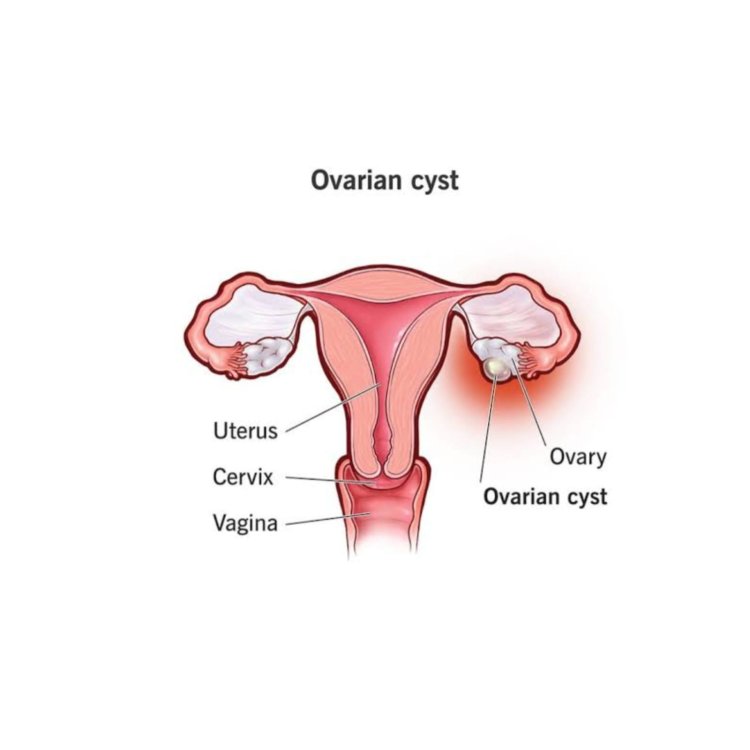Ovarian cysts cause and dignose
Ovarian cysts are common growths that develop on or inside your ovaries. There are several types of cysts. The most common kinds are harmless, don’t cause symptoms and eventually go away without treatment. Rarely, cysts can cause complications that require your provider’s attention. Getting regular pelvic exams can help reduce your chances of experiencing problems with a cyst. The outlook for premenopausal women with ovarian cysts is good. Most cysts disappear within a few months.

What are ovarian cysts?
The ovaries are part of the female reproductive system. They’re located in the lower abdomen on both sides of the uterus. Women have two ovaries that produce eggs as well as the hormones estrogen and progesterone.
Sometimes, a fluid-filled sac called a cyst will develop on one of the ovaries. Many women will develop at least one cyst during their lifetime. In most cases, cysts are painless and cause no symptoms.
Types of ovarian cysts
There are various types of ovarian cysts, such as dermoid cysts and endometrioma cysts. However, functional cysts are the most common type. The two types of functional cysts include follicle and corpus luteum cysts.
Follicle cyst
During a woman’s menstrual cycle, an egg grows in a sac called a follicle. This sac is located inside the ovaries. In most cases, this follicle or sac breaks open and releases an egg. But if the follicle doesn’t break open, the fluid inside the follicle can form a cyst on the ovary.
Corpus luteum cysts
Follicle sacs typically dissolve after releasing an egg. But if the sac doesn’t dissolve and the opening of the follicle seals, additional fluid can develop inside the sac, and this accumulation of fluid causes a corpus luteum cyst.
Other types of ovarian cysts include:
dermoid cysts: sac-like growths on the ovaries that can contain hair, fat, and other tissue
cystadenomas: noncancerous growths that can develop on the outer surface of the ovaries
endometriomas: tissues that normally grow inside the uterus can develop outside the uterus and attach to the ovaries, resulting in a cyst.
Some women develop a condition called polycystic ovary syndrome. This condition means the ovaries contain a large number of small cysts. It can cause the ovaries to enlarge. If left untreated, polycystic ovaries can cause infertility.
Symptoms of an ovarian cyst
Often times, ovarian cysts do not cause any symptoms. However, symptoms can appear as the cyst grows. Symptoms may include:
abdominal bloating or swelling
painful bowel movements
pelvic pain before or during the menstrual cycle
painful intercourse
pain in the lower back or thighs
breast tenderness
nausea and vomiting
Severe symptoms of an ovarian cyst that require immediate medical attention include:
severe or sharp pelvic pain
fever
faintness or dizziness
rapid breathing
These symptoms can indicate a ruptured cyst or an ovarian torsion. Both complications can have serious consequences if not treated early.
Ovarian cyst complications
Most ovarian cysts are benign and naturally go away on their own without treatment. These cysts cause little, if any, symptoms. But in a rare case, your doctor may detect a cancerous cystic ovarian mass during a routine examination.
Ovarian torsion is another rare complication of ovarian cysts. This is when a large cyst causes an ovary to twist or move from its original position. Blood supply to the ovary is cut off, and if not treated, it can cause damage or death to the ovarian tissue. Although uncommon, ovarian torsion accounts for nearly 3 percent of emergency gynecologic surgeries.
Ruptured cysts, which are also rare, can cause intense pain and internal bleeding. This complication increases your risk of an infection and can be life-threatening if left untreated.
Diagnosing an ovarian cyst
Your doctor can detect an ovarian cyst during a routine pelvic examination. They may notice swelling on one of your ovaries and order an ultrasound test to confirm the presence of a cyst. An ultrasound test (ultrasonography) is an imaging test that uses high-frequency sound waves to produce an image of your internal organs. Ultrasound tests help determine the size, location, shape, and composition (solid or fluid filled) of a cyst.
Imaging tools used to diagnose ovarian cysts include:
CT scan: a body imaging device used to create cross-sectional images of internal organs
MRI: a test that uses magnetic fields to produce in-depth images of internal organs
ultrasound device: an imaging device used to visualize the ovary
Because the majority of cysts disappear after a few weeks or months, your doctor may not immediately recommend a treatment plan. Instead, they may repeat the ultrasound test in a few weeks or months to check your condition.
If there aren’t any changes in your condition or if the cyst increases in size, your doctor will request additional tests to determine other causes of your symptoms.
These include:
pregnancy test to make sure you’re not pregnant
hormone level test to check for hormone-related issues, such as too much estrogen or progesterone
CA-125 blood test to screen for ovarian cancer
Treatment for an ovarian cyst
Your doctor may recommend treatment to shrink or remove the cyst if it doesn’t go away on its own or if it grows larger.
Birth control pills
If you have recurrent ovarian cysts, your doctor can prescribe oral contraceptives to stop ovulation and prevent the development of new cysts. Oral contraceptives can also reduce your risk of ovarian cancer. The risk of ovarian cancer is higher in postmenopausal women.
Laparoscopy
If your cyst is small and results from an imaging test to rule out cancer, your doctor can perform a laparoscopy to surgically remove the cyst. The procedure involves your doctor making a tiny incision near your navel and then inserting a small instrument into your abdomen to remove the cyst.
Laparotomy
If you have a large cyst, your doctor can surgically remove the cyst through a large incision in your abdomen. They’ll conduct an immediate biopsy, and if they determine that the cyst is cancerous, they may perform a hysterectomy to remove your ovaries and uterus.
Ovarian cyst prevention
Ovarian cysts can’t be prevented. However, routine gynecologic examinations can detect ovarian cysts early. Benign ovarian cysts don’t become cancerous. However, symptoms of ovarian cancer can mimic symptoms of an ovarian cyst. Thus, it’s important to visit your doctor and receive a correct diagnosis. Alert your doctor to symptoms that may indicate a problem, such as:
changes in your menstrual cycle
ongoing pelvic pain
loss of appetite
unexplained weight loss
abdominal fullness
What’s the long-term outlook?
The outlook for premenopausal women with ovarian cysts is good. Most cysts disappear within a few months. However, recurrent ovarian cysts can occur in premenopausal women and women with hormone imbalances.
If left untreated, some cysts can decrease fertility. This is common with endometriomas and polycystic ovary syndrome. To improve fertility, your doctor can remove or shrink the cyst. Functional cysts, cystadenomas, and dermoid cysts do not affect fertility.
Although some doctors take a “wait and see” approach with ovarian cysts, your doctor may recommend surgery to remove and examine any cyst or growth that develops on the ovaries after menopause. This is because the risk of developing a cancerous cyst or ovarian cancer increases after menopause. However, ovarian cysts don’t increase the risk of ovarian cancer. Some doctors will remove a cyst if it’s larger than 5 centimeters in diameter.
Q. Who is affected by ovarian cysts?
Anyone with ovaries can develop an ovarian cyst. Your chances increase based on your:
Age. Ovarian cysts are more common if you haven’t gone through menopause.
Pregnancy status. Cysts are more likely to form and remain during pregnancy.
History of ovarian cysts. You’re more likely to have an ovarian cyst if you’ve had one before.
Current medical conditions. You’re more likely to get an ovarian cyst if you have: endometriosis, hormone problems or if you’re taking medications to help with ovulation, like clomiphene (Clomid©).
How common are ovarian cysts?
Ovarian cysts are extremely common, especially if you haven’t gone through menopause yet. Functional cysts are the most common type of ovarian cyst.
Are ovarian cysts serious?
Usually, no. Most ovarian cysts are harmless, and they often go away on their own eventually. Some types of cysts are more likely to become cancerous or cause complications, but this is rare. Less than 1% of ovarian cysts are cancerous. And your provider can monitor any concerning cysts closely to reduce your risk of experiencing complications.
SYMPTOMS AND CAUSES
What causes an ovarian cyst?
Ovulation is the leading cause of ovarian cysts. Other causes include:
Abnormal cell reproduction. Atypical cell reproduction can cause cysts like dermoids and cystadenomas to form.
Endometriosis. These cysts often form on the ovary in the advanced stages of endometriosis.
Pelvic inflammatory disease (PID). Severe pelvic infections can spread to your ovaries, causing cysts.
What are the signs and symptoms of an ovarian cyst?
Some smaller cysts cause no symptoms. In these cases, you may not even know you have a cyst. Larger cysts may cause:
Pelvic pain or a dull ache in your back.
A feeling of fullness (bloating) located in your lower belly that may feel more pronounced on one side of your body.
Pain during intercourse (dyspareunia).
Painful periods.
Symptoms that linger could indicate a condition called polycystic ovary syndrome (PCOS). PCOS is a condition that causes irregular periods and other hormone-related problems, including obesity and infertility. Other symptoms of polycystic ovary syndrome include hirsutism (increased growth of body hair) and difficulty losing weight.
What does it feel like when you have a cyst on your ovary?
The experience of having an ovarian cyst varies from person to person. You may feel:
No pain at all.
Mild discomfort or a feeling of fullness.
Pain that could be described as sharp or like a dull ache.
Discomfort or pain that comes and goes without explanation.
Can you gain weight with an ovarian cyst?
Yes. Cysts can cause bloating, which contributes to weight gain. Some cysts secrete hormones that can cause you to gain weight.
What are the complications of an ovarian cyst?
Cancerous cyst. Ovarian cysts that develop after menopause are more likely to be cancerous than cysts that form before menopause.
Ruptured ovarian cyst. Functional cysts commonly rupture without causing any negative symptoms. But sometimes, a ruptured cyst can cause severe pain and swelling in your belly. The larger it is, the greater likelihood it has of breaking.
Ovarian torsion. Cysts can grow so big that they distort the shape of your ovary, increasing the likelihood that it’ll twist. The twisting can prevent blood flow to your ovary, causing it to die. Extreme pain, nausea and vomiting are all signs of ovarian torsion.
Seek medical assistance right away if you’re experiencing the symptoms of a ruptured ovarian cyst or ovarian torsion.
DIAGNOSIS AND TESTS
How is an ovarian cyst diagnosed?
Your healthcare provider will first rule out pregnancy as the cause of your symptoms. Then, they may use the following tests to diagnose an ovarian cyst:
A pelvic exam: Your provider will feel inside your pelvis for any lumps or changes.
Ultrasound: This imaging procedure uses sound waves to create images of your body's internal organs. It can detect cysts on your ovaries, including their location and whether they’re primarily fluid or solid.
Laparoscopy: This is a procedure performed in an operating room. Your provider inserts a camera through an incision (cut) in your abdomen and can view your reproductive organs and pelvic cavity. If your provider diagnoses a cyst at this time, they can remove it.
Click Here to Visit














